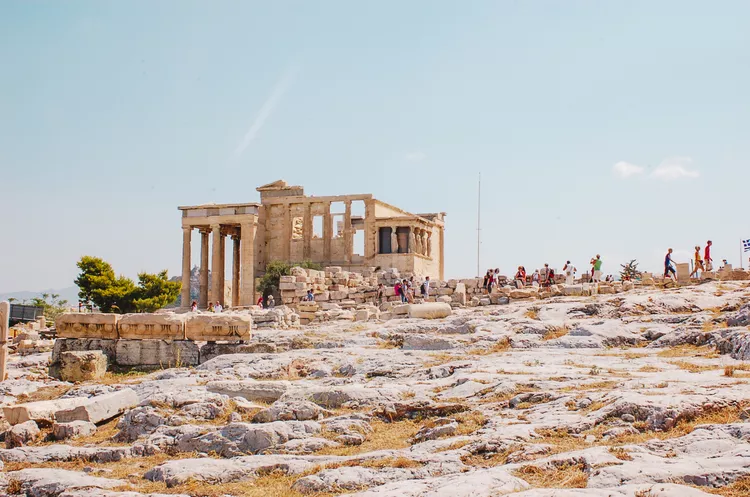Summary
At the Parthenon in Athens, you’ll see the remains of a temple built for the Greek goddess Athena, the patron goddess of the ancient City of Athens, in 438 BC. The Parthenon is located on the Acropolis, a hill overlooking the city of Athens, Greece.
About the Acropolis
Acro means “high” and polis means “city,” so Acropolis means the “high city.” Many other places in Greece have an acropolis, such as Corinth in the Peloponnese, but the Acropolis usually refers to the site of the Parthenon in Athens.
When the Parthenon was built, Lycabettus Hill was outside the Athens city limits. However, Lycabettus is now the highest hill in Athens.
Climb it for a brilliant view of the Acropolis and the Parthenon.
In addition to the prominent classical monuments at the Acropolis, there are more ancient remains dating from the Mycenean period and earlier. Moreover, you can see in the distance the sacred caves that were once used for rites to Dionysos and other Greek deities, although these are typically not open to the public.
The Acropolis Museum is located beside the rock of the Acropolis and houses many of the finds from the Acropolis and Parthenon, having replaced the old museum that formerly occupied the site.
About the Parthenon
The Parthenon in Athens is widely considered to be the finest example of Doric-style construction, characterized by its simple and unadorned columns. The best estimate of the Parthenon’s original size is approximately 111 feet by 228 feet, or 30.9 meters by 69.5 meters.
Designed by the renowned sculptor Phidias at the behest of Pericles, a pivotal figure in ancient Athens credited with stimulating the “Golden Age of Greece,” the Parthenon’s construction was overseen by architects Ictinos and Callicrates. Due to the lack of standardized transliteration from Greek to English, you may encounter various spellings of these names.
Construction began in 447 BC and continued for about nine years until its official completion in 438 BC, although some decorative elements were finalized later. Furthermore, it was built on the site of an earlier temple sometimes referred to as the Pre-Parthenon. Archaeological findings suggest the presence of even older Mycenean remains at the Acropolis.
The temple was dedicated to two iterations of the Greek goddess Athena: Athena Polios (“of the city”) and Athena Parthenos (“young maiden”). Thus, the term “Parthenon” literally translates to “place of the Parthenos.”
The building housed many treasures, with the highlight being a monumental statue of Athena, crafted by Phidias using chryselephantine, a luxurious material made from ivory and gold.
Remarkably, the Parthenon survived significant historical events, serving various functions as a church, then a mosque, before being utilized as a munitions depot during the Turkish occupation of Greece. From 1453, following the fall of Constantinople, Greece was under Ottoman rule until the revolution in 1821.
In 1687, during a conflict with the Venetians, an explosion devastated parts of the structure, resulting in the damage visible to this day.
The “Elgin Marbles” or “Parthenon Marbles” Controversy
In the early 1800s, Lord Elgin, an Englishman, asserted he received permission from local Turkish authorities to remove artifacts from the ruins of the Parthenon; however, surviving documents suggest he may have interpreted this “permission” quite liberally. Consequently, the Greek government has been vocal in demanding the return of the Parthenon Marbles, with an entire vacant floor awaiting them at the Acropolis Museum. Currently, these marbles are exhibited at the British Museum in London, England.
Visiting the Acropolis and Parthenon
Numerous companies offer tours of the Parthenon and the Acropolis, allowing you to join a guided experience for a modest fee in addition to your site admission. Alternatively, you may choose to explore independently, reading the limited information provided on curation cards. One recommended guided tour is the Athens Half-Day Sightseeing Tour with Acropolis and Parthenon. Moreover, from November to March, the first Sunday of each month offers free entry to the Parthenon.
For optimal photography during your visit, the best perspective of the Parthenon comes from the far end, rather than the immediate view after ascending through the propylaion, which can present challenging angles for most cameras. Additionally, turning around provides an opportunity to capture stunning images of Athens from that location.




